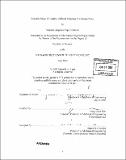| dc.contributor.advisor | Sang-Gook Kim. | en_US |
| dc.contributor.author | Vega González, Myraida Angélica | en_US |
| dc.contributor.other | Massachusetts Institute of Technology. Dept. of Mechanical Engineering. | en_US |
| dc.date.accessioned | 2006-05-15T20:42:35Z | |
| dc.date.available | 2006-05-15T20:42:35Z | |
| dc.date.copyright | 2005 | en_US |
| dc.date.issued | 2005 | en_US |
| dc.identifier.uri | http://hdl.handle.net/1721.1/32967 | |
| dc.description | Thesis (S.B.)--Massachusetts Institute of Technology, Dept. of Mechanical Engineering, 2005. | en_US |
| dc.description | Includes bibliographical references (leaf 31). | en_US |
| dc.description.abstract | This study examines the dynamic characteristics of the in-plane tunable stiffness scanning microscope probe for an atomic force microscope (AFM). The analysis was carried out using finite element analysis (FEA) methods for the micro scale device and its macro scale counterpart, which was designed specifically for this study. Experimental system identification testing using sound wave and high-speed camera recordings was clone on the macro scale version to identify trends that were then verified in the micro scale predictions. The results for the micro scale device followed the trends predicted by the macro scale experimental data. The natural frequencies of the device corresponded to the three normal directions of motion, in ascending order from the vertical direction, the out-of- plane direction, and the horizontal direction. The numerical values for these frequencies in the micro scale are 81.314 kHz, 51.438 kHz, and 54.899 kHz for the X, Y, and Z directions of vibration respectively. The error associated with these measurements is 6.6% and is attributed to the high tolerance necessary for measurements in the micro scale, which was not matched by the macro scale data acquisition methods that predict the natural frequency range. | en_US |
| dc.description.abstract | (cont.) The vertical vibrations are therefore the limiting factor in the scanning speed of the probe across a sample surface, thus requiring the AFM to scan at an effective frequency of less than 81.3 kHz to avoid resonance. | en_US |
| dc.description.statementofresponsibility | by Myraida Angélica Vega González. | en_US |
| dc.format.extent | 41 leaves | en_US |
| dc.format.extent | 1671269 bytes | |
| dc.format.extent | 1671136 bytes | |
| dc.format.mimetype | application/pdf | |
| dc.format.mimetype | application/pdf | |
| dc.language.iso | eng | en_US |
| dc.publisher | Massachusetts Institute of Technology | en_US |
| dc.rights | M.I.T. theses are protected by copyright. They may be viewed from this source for any purpose, but reproduction or distribution in any format is prohibited without written permission. See provided URL for inquiries about permission. | en_US |
| dc.rights.uri | http://dspace.mit.edu/handle/1721.1/7582 | |
| dc.subject | Mechanical Engineering. | en_US |
| dc.title | Dynamic study of tunable stiffness scanning microscope probe | en_US |
| dc.type | Thesis | en_US |
| dc.description.degree | S.B. | en_US |
| dc.contributor.department | Massachusetts Institute of Technology. Department of Mechanical Engineering | |
| dc.identifier.oclc | 62860205 | en_US |
